
Progressive house is a melodic, long-form strain of house music known for gradual builds, evolving textures, and a strong sense of tension and release. It favors hypnotic grooves, lush pads, and emotive chord progressions over abrupt drops.
Typically sitting around 122–128 BPM in 4/4 time, tracks unfold over six to nine minutes, introducing small changes every few bars to keep momentum. The sound balances club-focused punch with cinematic atmosphere, making it equally at home in late-night dancefloors and long-form DJ sets.
Progressive house emerged in the United Kingdom in the early 1990s as DJs and producers sought a deeper, more expansive alternative to straightforward house. It drew on the groove and structure of house, the atmosphere of ambient house and Balearic beat, the melodic sensibility of Italo house, and the build-and-release dynamics that were also shaping trance and techno. Early DJs and clubs (e.g., Renaissance) championed long, narrative-style sets that encouraged the genre’s extended arrangements.
By the mid-1990s, compilations and touring DJs helped establish a recognizable “prog” sound worldwide: rolling basslines, layered percussion, silky pads, and patient transitions. The era saw cross-pollination with trance and breakbeat, spawning closely related strains like progressive trance and progressive breaks. Labels and mix series spread the aesthetic, and the sound became synonymous with sophisticated, journey-oriented DJ sets.
In the 2000s, a new wave of producers refreshed the genre with modern sound design, tighter low-end, and distinctive arrangement techniques (e.g., characteristic snare fills and plucked lead motifs). Progressive house absorbed elements from electro house while retaining its emphasis on progression over shock-value drops, yielding highly polished, emotive club records.
During the 2010s, “progressive house” was sometimes used commercially to describe festival-oriented big-room tracks, causing confusion. Meanwhile, the underground continued to develop the classic progressive ethos—long sequences, intricate automation, and deep, melodic frameworks—often overlapping with what came to be marketed as “melodic house & techno.” Dedicated labels and artists preserved the genre’s narrative, immersive approach.
The 2020s have seen continued refinement in sound design and mixing, with artists emphasizing warmth, subtle motion, and DJ-friendly structures. The genre remains a bridge between deep, hypnotic house and emotive, trance-adjacent melodicism, thriving in clubs, festivals’ deeper stages, and long-form streaming mixes.

